基于 Barrier Lyapunov 函数的严格反馈系统的
http://www.paper.edu.cn
全状态约束控制
王春晓,武玉强
曲阜师范大学工学院,日照,276862
摘要: 本文研究了非对称时变全状态约束的严格反馈非线性系统的自适应控制问题。时变非
对称障碍李雅普诺夫函数的引入保证了状态约束条件的满足。时变的障碍李雅普诺夫函数可以
随着跟踪轨迹的改变而做相应调整从而放松了对于初始条件的要求,所以时变非对称的障碍李
雅普诺夫函数在控制设计中更具灵活性。首次通过变量代换及虚拟误差的界限消除了由反步法
所带来的高阶交叉项,所设计的控制器在不破坏任何约束条件的前提下最终达到了渐近跟踪,
并且闭环系统的所有信号最终有界。最后给出数值例子验证了控制器的性能。
关键词:非线性严格反馈系统;非对称障碍李雅普诺夫函数;时变;全状态约束;反步法.
中图分类号: O231.3
Barrier Lyapunov Function-based control for
strict-feedback systems with full state constraints
WANG Chun-xiao, WU Yu-qiang
Department of Engineering, Qufu Normal University, Rizhao, 276862
Abstract: This paper studies an adaptive control design for a class of strict-feedback
nonlinear systems with asymmetric time-varying full state constraints. A time-varying
asymmetric Barrier Lyapunov Function (ABLF) is employed to ensure time-varying
constraints satisfaction. By allowing the barriers to vary with the desired trajectory in time,
the initial condition requirements are relaxed. Thus the ABLF can afford greater flexibility in
control design. The high order coupling terms caused by backstepping method are canceled
through variable substitution. Asymptotic tracking is achieved without violation of any
constraints, and all signals in the closed-loop system are ultimately bounded. The
performance of the ABLF-based control is illustrated through a numerical example.
Key words: nonlinear strict-feedback system; ABLF; time-varying; full state constraints;
backstepping.
Foundations: The PhD Programs Foundation of Ministry of Education of China under Grant 20123705110002, National
Natural Science Foundation (61273091, 61303198 and 61304008),the Project of Taishan Scholar of Shandong Province of
China.
Author Introduction: Wang Chun-xiao(1979-),female,associate professor,major research direction:nonlinear system
control and adaptive control. Correspondence author:Wu Yu-qiang (1962-),male,professor,major research direction:
variable structure control, switching control, nonlinear system control.
- 1 -
�
http://www.paper.edu.cn
0 Introduction
Constraints are ubiquitous in practical systems [1]. Violation of constraints may cause
undesirable performance, degradation, hazards or system damage. Driven by practical require-
ments and theoretical challenges, the research of constrained problem has become an attractive
research topic [2]–[6]. Model predictive control [7, 8], set invariance notions [9, 10], and reference
governors [11, 12] are the main methods to handle constraints. Additionally, barrier Lyapunov
Functions (BLFs) have been proposed to guarantee the output and state constraints for vari-
ous kinds of nonlinear systems such as Brunovsky form [13], strict-feedback form [14]–[17], and
pure-feedback form [18, 19].
In recent years, the study of constrained strict-feedback nonlinear systems have attracted
scholars’ attention. BLF was first employed to deal with the tracking control problems for a
class of strict-feedback nonlinear systems with an output constraint in [14].
[3, 15] improved
the result to strict-feedback nonlinear systems with time-varying output constraint by using
a time-varying BLF. Besides the output constraint mentioned in the above works, the state
constraints have also been tackled by using BLF. For example, strict-feedback nonlinear system
with partial state constraints [20] and the full state constraints [21]–[23] were studied using
BLF. However, the existing results are only available for strict-feedback system with static
state constraints. One more interesting work is to consider the strict-feedback system with
time-varying state constraints. The main difficulties of handling the problem is to deal with
the high order coupling terms
Motivated by the above observations, in this paper, we employ the time-varying ABLF-
based adaptive control to handle the strict-feedback system with asymmetric time-varying full
state constraints. The main contributions of this paper are summarized as follows: (1) Time-
varying ABLF-based backstepping design is proposed to prevent the violation of the full state
constraints and asymptotic output tracking is achieved. (2) An efficient method is given to
cancel the high order coupling terms for the first time. (3) The proposed control scheme is able
to handle the state constraints that are both time-varying and asymmetric.
The rest of the paper is organized as follows. In Section 1, some mathematical preliminaries
and statement of the problem are provided. The controller design procedure and the main
results are developed in Section 2. A numerical example is given in Section 3 to illustrate the
obtained results. Section 5 concludes this paper.
- 2 -
�
http://www.paper.edu.cn
1 Problem Statement
Consider the following strict-feedback nonlinear systems with time-varying full state con-
straints
˙xi(t) = fi(¯xi(t)) + gi(¯xi(t))xi+1(t); i = 1; 2;··· ; n − 1;
˙xn(t) = fn(x(t)) + gn(x(t))u(t);
y(t) = x1(t);
(1)
where f1(·);··· ; fn(·); g1(·);··· ; gn(·) are known smooth functions, x(t) = (x1(t);··· ; xn(t)) ∈
Rn are the system states and ¯xi = (x1;··· ; xi)T . u(t) ∈ R and y(t) ∈ R are the control
input and output respectively. Furthermore, all the states are required to be constrained in a
(t) < xi(t) < ¯kci(t);∀t ≥ 0}, where ¯kci(t) : R+ → R
time-varying sets as Ωxi := {xi(t) ∈ R; kci
(t);∀t ≥ 0.
(t) : R+ → R such that ¯kci(t) > kci
and kci
Remark 1. The state constraints kci
(t) < xi(t) < ¯kci(t) considered in this paper are
based on the worst-case scenario. The designed constraint functions can be specified according
to practical problem’s requirements. The constraints kci
(t); ¯kci(t) should be ensured to satisfy
(t) < i1(t) < ¯kci(t); i = 1;··· ; n, in which i1 are the virtual stabilizing functions to be
kci
designed.
The control objective is to track a designed trajectory yd(t) while to ensure that the time-
varying full state constraints are not violated and all closed-loop signals are bounded. To
achieve the control objective, we make the following assumptions on system (1).
constant g0 such that 0 < g0 ≤ |gi(·)| for kci
this paper, we further assume that gi(·) are all positive.
Assumption 1. The functions gi(·)(i = 1; : : : ; n) are known, and there exist a positive
(t) < xi(t) < ¯kci(t). Without loss of generality, in
Assumption 2. There exist functions ¯Y0 : R+ → R+ and Y 0 : R+ → R+ satisfying
(t);∀t ≥ 0, and positive constants Yi; i = 1;··· ; n; such that the
d (t)| ≤ Yi,
; ¯dcij i; j = 1;··· ; n, such that ¯kci(t) ≤
¯Y0(t) < ¯kc1(t) and Y 0(t) > kc1
reference signal yd(t) and its time derivatives satisfy Y 0(t) ≤ yd(t) ≤ ¯Y0(t) and |y(i)
i = 1;··· ; n;∀t ≥ 0.
Assumption 3. There exist constants ¯Kci; K ci
and their derivatives satisfy |k(j)
(t) ≥ K ci
, dcij
(t)| ≤ dcij
;|¯k(j)
ci (t)| ≤ ¯dcij.
¯Kci; kci
ci
Definition 1 [14]. BLF is a continuously differentiable and positive definite scalar func-
tion V (x), defined with respect to the system ˙x = f (x) on an open region D containing the
origin. It has continuous first-order partial derivatives at every point of D, has the property
V (x) → ∞ as x approaches the boundary of D. It satisfies V (x) ≤ b;∀t ≥ 0 along the solution
of ˙x = f (x) for x(0) ∈ D and some positive constant b.
The following lemmas about BLF are useful for establishing constraint satisfaction and
stability analysis.
- 3 -
�
http://www.paper.edu.cn
Lemma 1 [14]. For any functions kaj (t); kbj (t), let ¯Zi := {zj(t) ∈ R : −kaj (t) < zj(t) <
kbj (t); j = 1; 2; : : : ; i;∀t ≥ 0} ⊂ Ri and N := Rl× ¯Zi ⊂ Rl+i be open sets. Consider the system
(2)
where (t) := [!(t); ¯zi(t)]T ∈ N , and h : R+×N → Rl+i is piecewise continuous with respect to
t and locally Lipschitz about , uniformly in t, on R+×N . Suppose that there exist continuous
differentiable and positive definite functions U : Rl → R+ and Vi : ¯Zi → R+ in their respective
domains, such that
˙(t) = h(t; (t));
Vj(zj(t)) → ∞ as
1(∥!∥) ≤ U (!) ≤ 2(∥!∥);
zj → −kaj
or
∑
zj → kbj ; j = 1;··· ; i;
where 1 and 2 are class K1 functions. Let V () :=
to the set ¯Zi. If the inequality holds
i
j=1 Vj(zj(t)) + U (!) and ¯zi(0) belong
˙V =
h ≤ 0;
@V
@
then ¯zi(t) remain in the open set ¯Zi;∀t ∈ [0;∞].
Lemma 2 [15]. For all |Si| < kbi(t), the following inequality holds
log
k2
bi
(t)
k2
(t) − S2
bi
i
≤
S2
(t) − S2
i
i
:
k2
bi
(3)
(4)
2 Time-varying ABLF-based control
In this section, we give a time-varying ABLF for system (1) as well as the corresponding
stability analysis. The control design is based on backstepping with time-varying ABLFs. For
giving the detailed backstepping design, we first give the change of coordinates as follows:
S1 = x1 − yd;
Si = xi − i1; i = 2;··· ; n;
where Si(i = 1;··· ; n) are called the virtual errors, i1(i = 2;··· ; n) are the intermediate
functions, which will be designed in Step i.
Step 1. Starting with the x1-subsystem, the time derivative of S1 = x1 − yd is
˙S1 = ˙x1 − ˙yd = f1(x1) + g1(x1)x2 − ˙yd
= f1(x1) + g1(x1)(S2 + 1) − ˙yd:
(5)
Since the state constraints are time-varying and asymmetric, we choose an ABLF as follows
1 − q(S1)
2p
log(
V1 =
(t)
k2p
a1
a1 (t) − S2p
k2p
1
) +
q(S1)
2p
log(
k2p
b1
- 4 -
(t)
k2p
b1
(t) − S2p
1
);
(6)
�
where p is a positive integer satisfying 2p ≥ n, the time-varying barriers are given by
http://www.paper.edu.cn
(t);
{
ka1(t) := yd(t) − kc1
kb1(t) := ¯kc1(t) − yd(t);
if • > 0;
q(•) :=
if • ≤ 0:
1;
0;
(7)
Remark 2. The aim of p chosen as 2p ≥ n in (6) is to ensure that the differentiability of
i for i = 1;··· ; n − 1. The selection of q(•) in (7) is to ensure that the Lyapunov function in
(6) can handle the case of asymmetric time-varying state constraints.
Due to Assumptions 2-3, there exist positive constants K b1
; ¯Kb1, and K a1
; ¯Ka1, such that
≤ ka1(t) ≤ ¯Ka1; K b1
K a1
(8)
Define a set Ωs := {−kai(t) < Si < kbi(t); kai(t) > 0; kbi(t) > 0; i = 1; 2;··· ; n}, where
kai(t); kbi(t) are specified later on for i = 2;··· ; n. In the set Ωs, V1 is continuous and differ-
entiable, then the time derivative of V1 is given by
≤ kb1(t) ≤ ¯Kb1:
˙V1 = S2p1
1
· (
1 − q(S1)
a1 (t) − S2p
k2p
1
+
q(S1)
(t) − S2p
1
k2p
b1
) · [ ˙S1 + (1 − q(S1))
˙ka1(t)
ka1(t)
S1 + q(S1)
˙kb1(t)
kb1(t)
S1]:
(9)
In order to simplify the formation, we define
Ks1(t) :=
1 − q(S1)
a1 (t) − S2p
k2p
1
+
q(S1)
(t) − S2p
1
;
k2p
b1
and
1 − q(Si)
ai (t) − S2p
k2p
will be used in the following. Then,
Ksi(t) :=
i
+
q(Si)
(t) − S2p
i
k2p
bi
; i = 2;··· ; n;
˙V1 = S2p1
1 Ks1[f1 + g1(S2 + 1) − ˙yd + (1 − q(S1))
˙ka1(t)
ka1(t)
S1 + q(S1)
˙kb1(t)
kb1(t)
S1]:
Design stabilising function 1 in the form of
1 =
1
g1
[−(K1 + ¯k1(t))S1 − f1 + ˙yd];
where K1 is a positive design parameter and the time-varying gain is given by
√
(1 − q(S1))(
¯k1(t) =
˙ka1
ka1
)2 + q(S1)(
˙kb1
kb1
)2 + :
(10)
(11)
(12)
(13)
(14)
Note that is a positive constant, then it guarantees that the differentiability of 1 and
boundedness of the time derivatives of 1 even when ˙ka1 and ˙kb1 are both zero.
- 5 -
�
Substituting (13) into (12), we get
˙V1 ≤ −K1Ks1(t)S2p
1 + Ks1(t)g1S2p1
1
http://www.paper.edu.cn
S2:
(15)
It is noted that the last term of inequality (15) is a high order coupling term which should be
canceled in the subsequent step.
Step i (i = 2;··· ; n− 1). Consider the xi-subsystem, Si = xi − i1. Take time derivative
of Si yields
˙Si = ˙xi − ˙i1 = fi + gixi+1 − ˙i1 = fi + gi(Si+1 + i) − ˙i1:
Consider the Lyapunov function
1 − q(Sj)
i∑
Vi =
[
j=1
2p
log(
(t)
k2p
aj
aj (t) − S2p
k2p
j
) +
q(Sj)
2p
log(
k2p
bj
(t)
k2p
bj
(t) − S2p
j
)];
(16)
(17)
(t); kbj (t) := ¯kcj (t) − j1(t). We select parameters Kj1 to
where kaj (t) := j1(t) − kcj
guarantee that kcj
(t) < j1(t) < ¯kcj (t), then kaj (t) > 0 and kbj (t) > 0 can be ensured.
Obviously, Vi is positive definite and continuously differentiable in the set Ωs. Then, the time
derivative of Vi is given by
˙Vi = ˙Vi1 + S2p1
i Ksi(t)[ ˙Si + (1 − q(Si))
Si + q(Si)
Si]
˙kbi(t)
kbi(t)
≤ − i1∑
˙kai(t)
kai(t)
j + Ksi1(t)gi1S2p1
i1 Si
KjKsj (t)S2p
j=1
+ S2p1
i Ksi(t)[fi + gi(Si+1 + i) − ˙i1 + (1 − q(Si))
˙kai(t)
kai(t)
Si + q(Si)
˙kbi(t)
kbi(t)
Si]: (18)
Design stabilising function i as
1
gi
i =
in which Ki is positive constant and the time-varying gain is given by
[−(Ki + ¯ki(t))Si − fi + ˙i1 + i]
√
(1 − q)(
)2 + q(
)2 + ;
¯ki(t) =
˙kai
kai
˙kbi
kbi
(19)
(20)
The last term of (19) i is used to eliminate the coupling term from the previous step. That is
to say the following inequality should be established.
i ≤ 0:
Adopting variable substitution, we can construct i as follows and
i1 Si + Ksi(t)S2p1
Ksi1(t)gi1S2p1
i
i = − gi1S2p1
i1 Si[q(Si)(kbi
ai1
(1 − q(Si1))(k2p
− Si) + (1 − q(Si))(−kai
− S2p
i1) + q(Si1)(k2p
bi1
− Si)]
− S2p
i1)
(21)
(22)
:
- 6 -
�
Substituting (19) into (18), then we have
˙Vi ≤ − i∑
j=1
KjKsj (t)S2p
j + Ksi(t)giS2p1
i
http://www.paper.edu.cn
Si+1:
(23)
Remark 3. Note that the high order coupling terms in this paper we hope to be canceled
meanwhile to guarantee that Si(i = 1;··· ; n) converges to zero as t → ∞. For this aim, we
firstly choose one of virtual errors and reduce its order to be quadratic by a variable substitution.
And then, combined with the bound of the chosen virtual error, we obtain the scope of vi(i =
2;··· ; n) for the four different cases. Fortunately, we can find a precise function vi from above
scopes for four cases. It can be guaranteed that vi is differentiable. The detailed procedure to
get (22) from (21) is provided in Appendix.
Step n. As denoted in Step n − 1, Sn = xn − n1, one has
˙Sn = ˙xn − ˙n1 = fn + gnu − ˙n1:
Choose the Lyapunov function as
1 − q(Sn)
q(Sn)
(t)
k2p
an
an(t) − S2p
k2p
n
2p
2p
) +
log(
log(
Vn = Vn1 +
(t) ≤ n1(t) ≤ ¯kcn(t), then kan(t) > 0 and kbn(t) > 0 hold.
(25)
(t); kbn(t) := ¯kcn(t) − n1. We also select parameters to guarantee
where kan(t) := n1 − kcn
that kcn
In the set Ωs, Vn is
continuous and differentiable. So in the same manner of the previous steps, computing the
time derivative of Vn, we have
˙Vn = ˙Vn1 + S2p1
n Ksn(t)[fn + gnu − ˙n1 + (1 − q)
Sn + q
k2p
bn
Sn]
);
(t)
k2p
bn
(t) − S2p
n
˙kan(t)
kan(t)
˙kbn(t)
kbn(t)
≤ − n1∑
(24)
(26)
(27)
KjKsj (t)S2p
j + Ksn1(t)gn1S2p1
n1 Sn
j=1
+ S2p1
n Ksn(t)[fn + gnu − ˙n1 + (1 − q)
˙kan(t)
kan(t)
Sn + q
˙kbn(t)
kbn(t)
Sn]:
Choose the control law as follows
u = − 1
gn
[−(Kn + ¯kn(t))Sn − fn + ˙n1 + n];
√
(1 − q)(
where Kn is positive constant and ¯kn(t) =
_kan
kan
is used to cancel the coupling term from step n − 1, and
)2 + q(
)2 + . The last term of (27)
_kbn
kbn
n = − gn1S2p1
n1 Sn[q(Sn)(kbn
(1 − q(Sn1))(k2p
an1
− Sn) + (1 − q(Sn))(−kan
− S2p
n1) + q(Sn1)(k2p
bn1
− Sn)]
n1)
− S2p
:
(28)
Substituting the control input (27) into (26), after simple calculation, it can be verified that
KjKsj (t)S2p
j :
(29)
˙Vn ≤ − n∑
j=1
- 7 -
�
This completes the controller design procedure.
http://www.paper.edu.cn
Theorem 1. Suppose the investigated system (1) satisfies the Assumptions 1–3. The
virtual controllers i; i = 1; 2;··· ; n − 1 in (13) and (19), the actual controller u in (27) are
constructed on the sets Ωs. Choosing appropriate positive design parameters Ki; i = 1;··· ; n,
given Si(0) ∈ Ωs = {−kai(t) < Si < kbi(t); kai(t) > 0; kbi(t) > 0; i = 1;··· ; n}, the resulting
closed-loop system has the following properties:
(i) The error signals Si(t); i = 1; 2;··· ; n are bounded by −Dsi
(t) ≤ Si(t) ≤ ¯Dsi(t);∀t ≥ 0,
√
√
1 − e2pVn(0)et, ¯Dsi(t) = kbi(t) 2p
1 − e2pVn(0)et with = min{2pKi;
(t) = kai(t) 2p
where Dsi
(i = 1;··· ; n)}.
(ii) All the signals in the closed-loop system are bounded.
(iii) The full state constraints are not violated.
(iv) The origin S = 0 is asymptotically stable.
Proof. (i) From (29) and Lemma 2, we have
˙Vn ≤ − n∑
≤ − n∑
i=1
i=1
≤ −Vn:
Ki[
1 − q(Si)
ai (t) − S2p
k2p
Ki[(1 − q(Si)) log
i
+
q(Si)
(t) − S2p
k2p
bi
k2p
ai
ai (t) − S2p
k2p
(t)
i
i
]S2p
i
+ q(Si) log
(t)
k2p
bi
(t) − S2p
i
]
k2p
bi
(30)
For Si(0) ∈ Ωs, then from Lemma 1 we get Si(t) ∈ Ωs;∀t ≥ 0. Multiplying both sides of (30)
by et, then integrating it over [0; t] , it has
Vn(t) ≤ Vn(0)e
t:
In view of (25), it is easy to obtain
1 − q(Si)
2p
log(
k2p
ai
− S2p
i
k2p
ai
) +
q(Si)
2p
log(
k2p
bi
− S2p
i
k2p
bi
) ≤ Vn(0)e
t:
Taking exponentials on both sides of (32), it yields
(1 − q(Si))
k2p
ai
− S2p
+ q(Si)
t
:
≤ e2pVn(0)e
k2p
bi
− S2p
i > 0 and k2p
i
i
ai
k2p
ai
Since −kai(t) < Si < kbi(t), we have k2p
q(Si) = 1. Multiplying both the sides by k2p
following inequality is obtained,
k2p
bi
(t) − S2p
√
1 − e2pVn(0)et:
Si(t) ≤ kbi(t) 2p
√
Similarly, when Si ≤ 0, q(Si) = 0, we obtain Si ≥ −kai(t) 2p
1 − e2pVn(0)et.
√
√
1 − e2pVn(0)et ≤ Si ≤ kbi(t) 2p
concluded as −kai(t) 2p
1 − e2pVn(0)et.
(t) − S2p
(t) − S2p
bi
i > 0. When Si > 0,
i > 0 and applying manipulations, the
bi
(34)
It could be
(31)
(32)
(33)
- 8 -
�
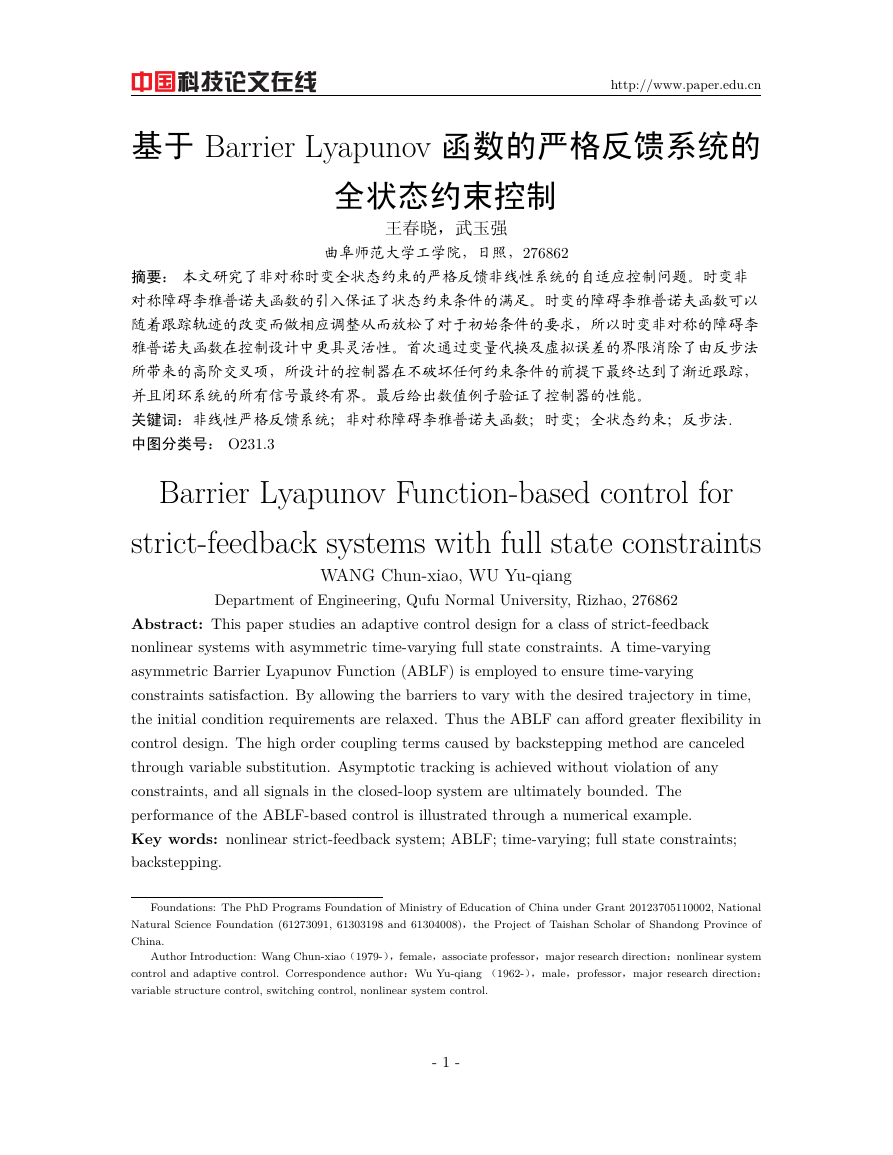
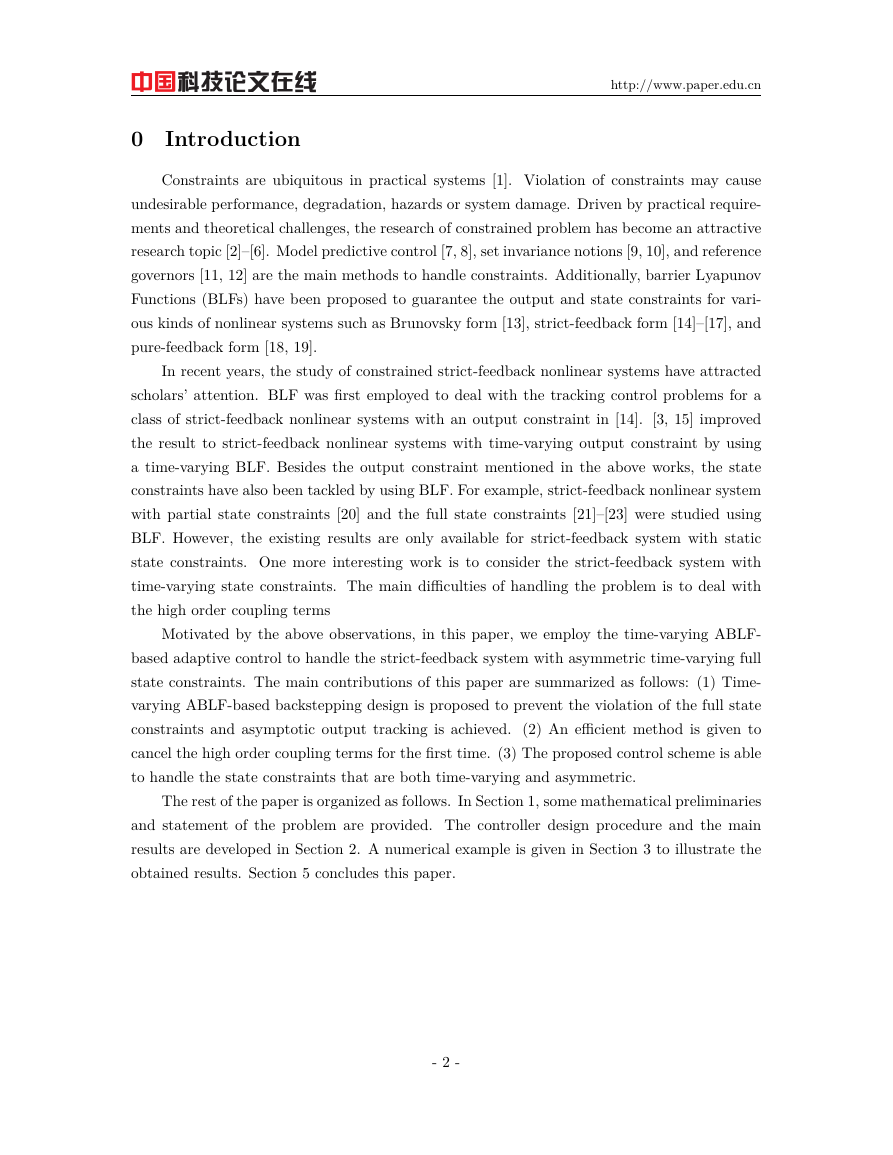
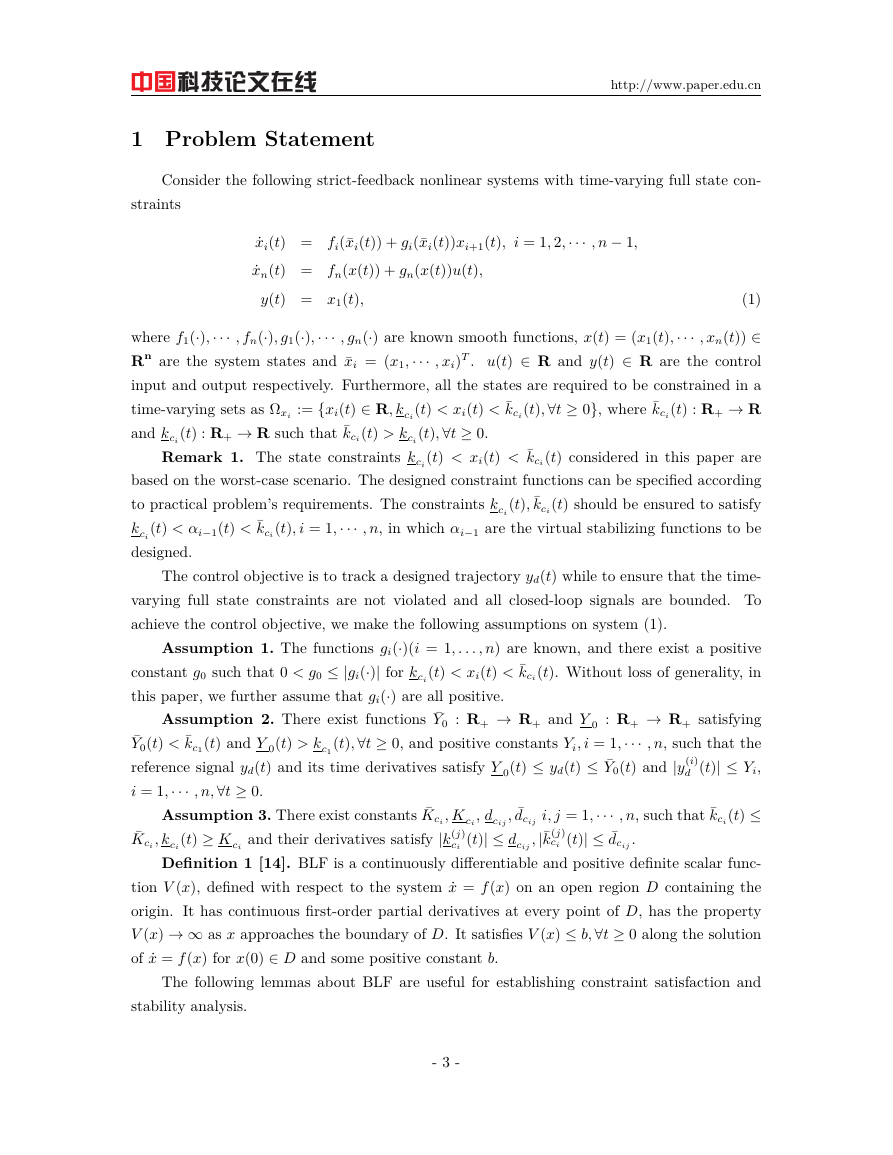
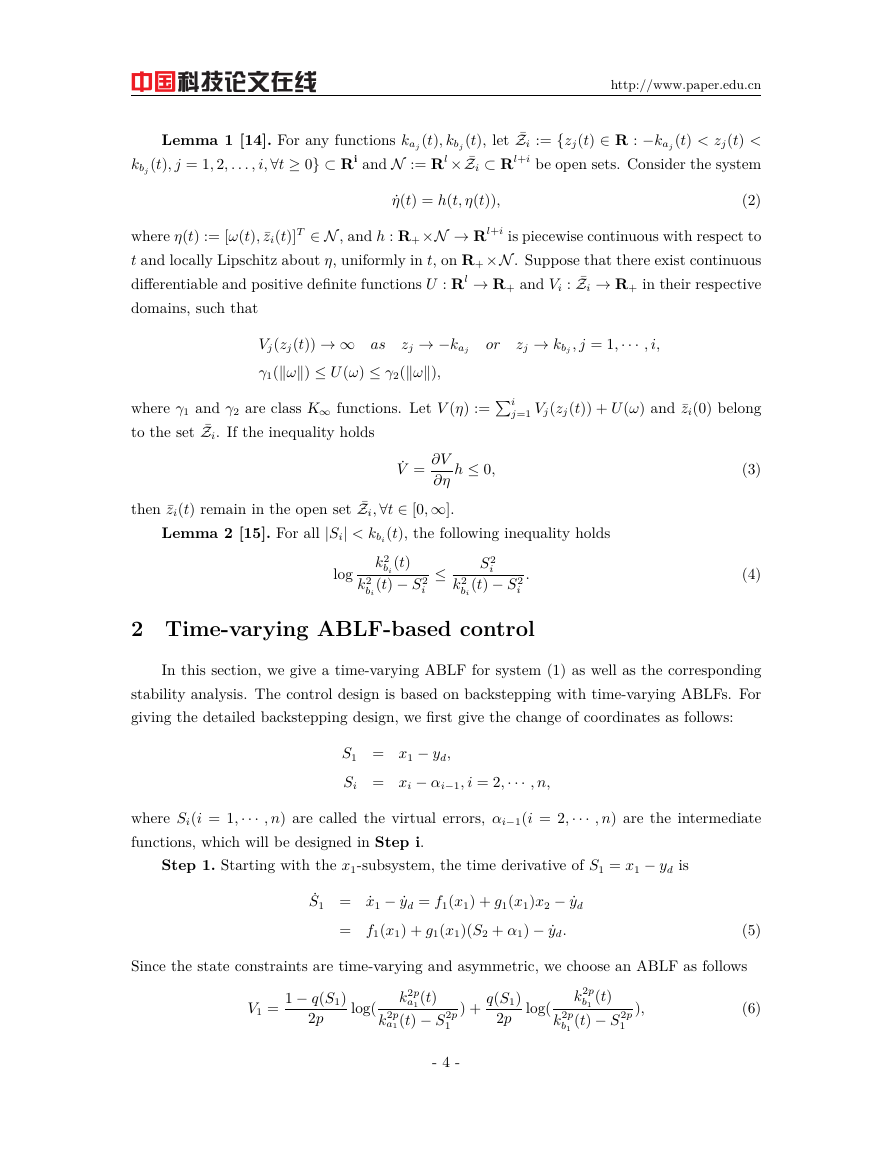
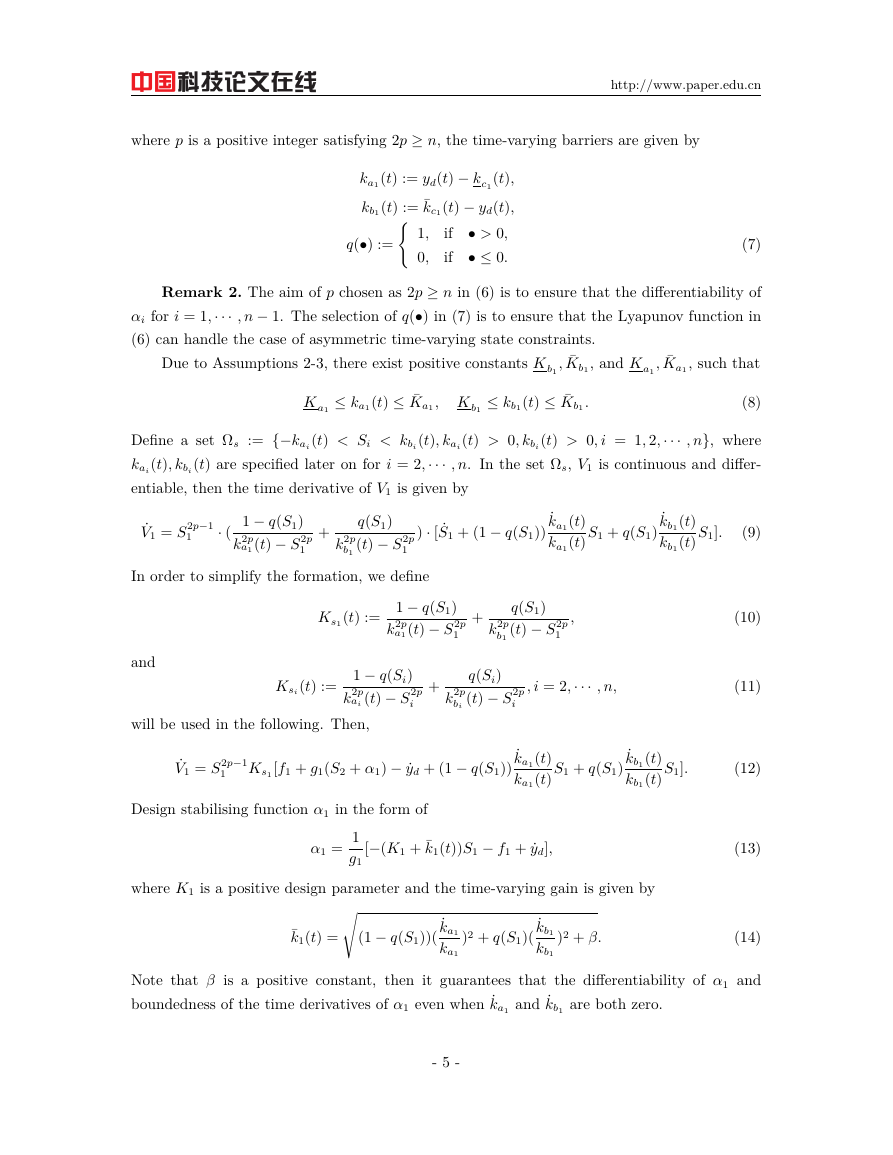
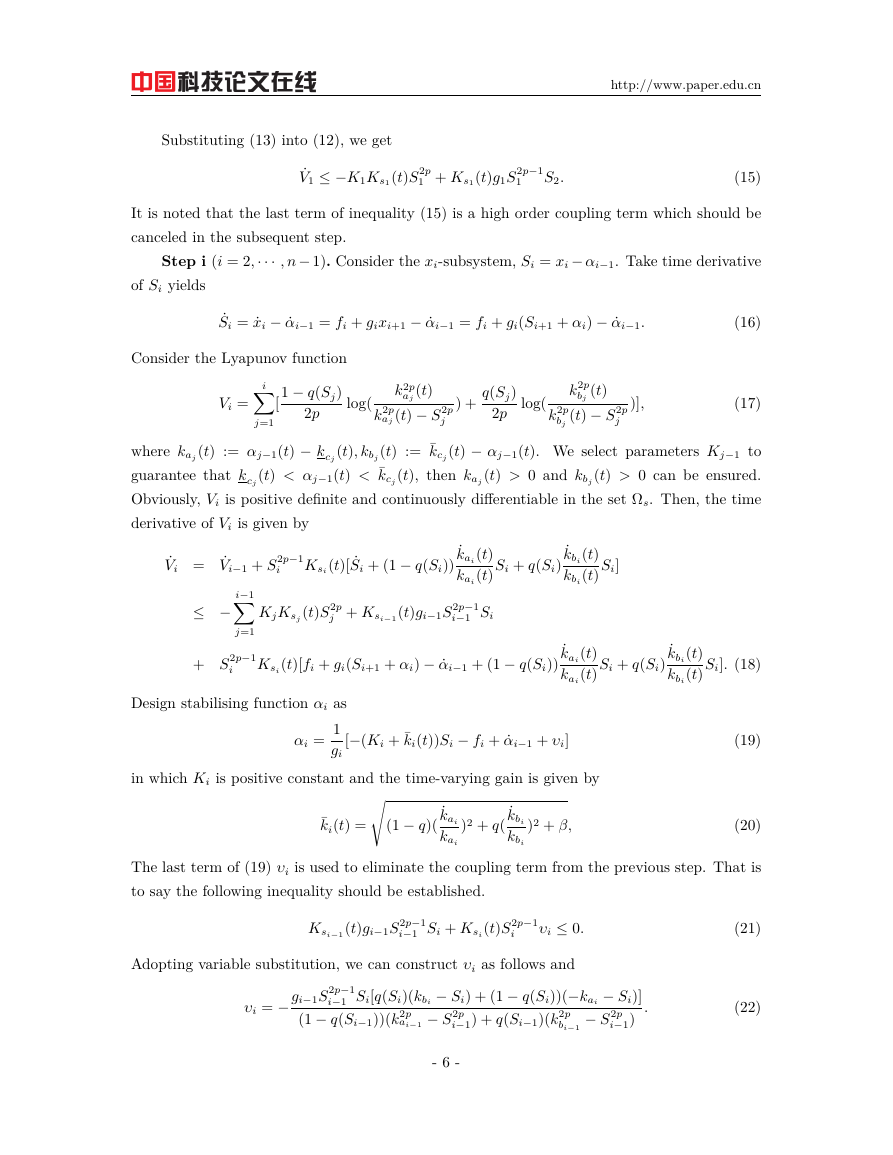
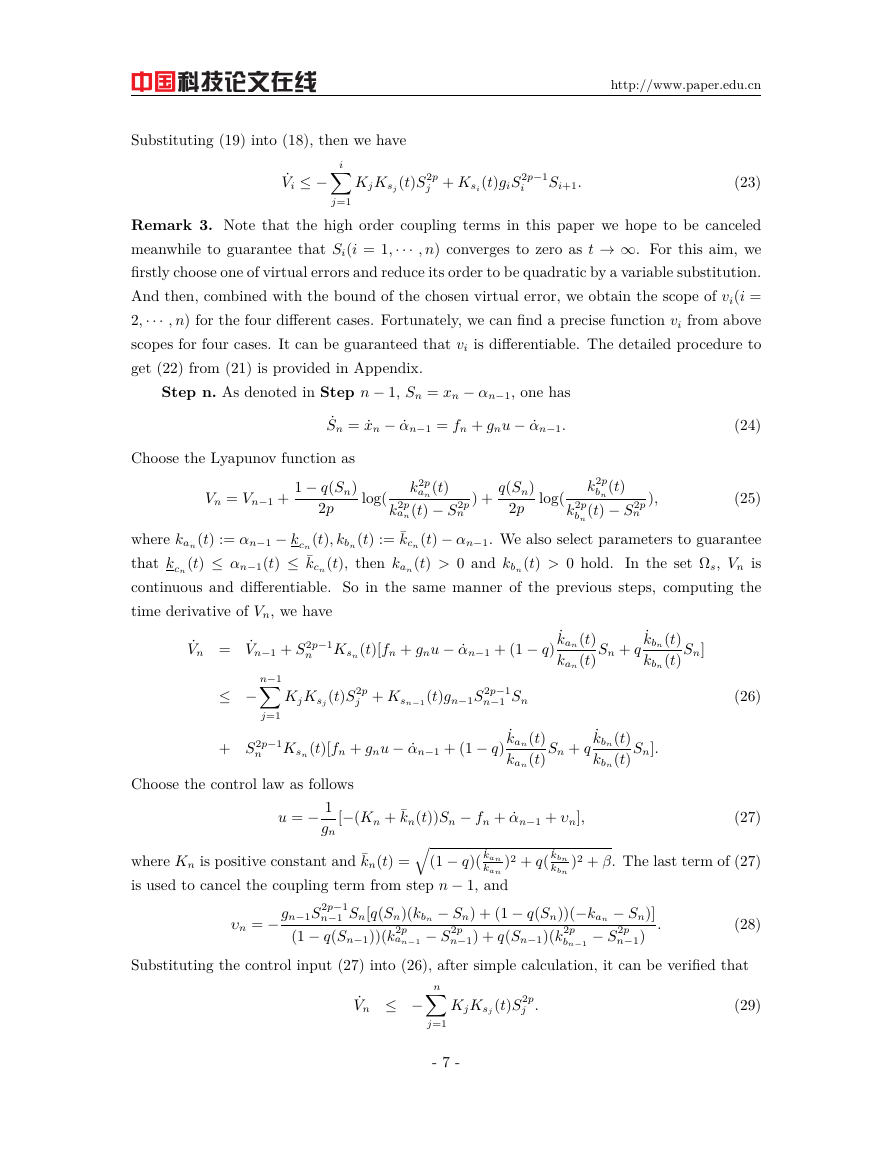
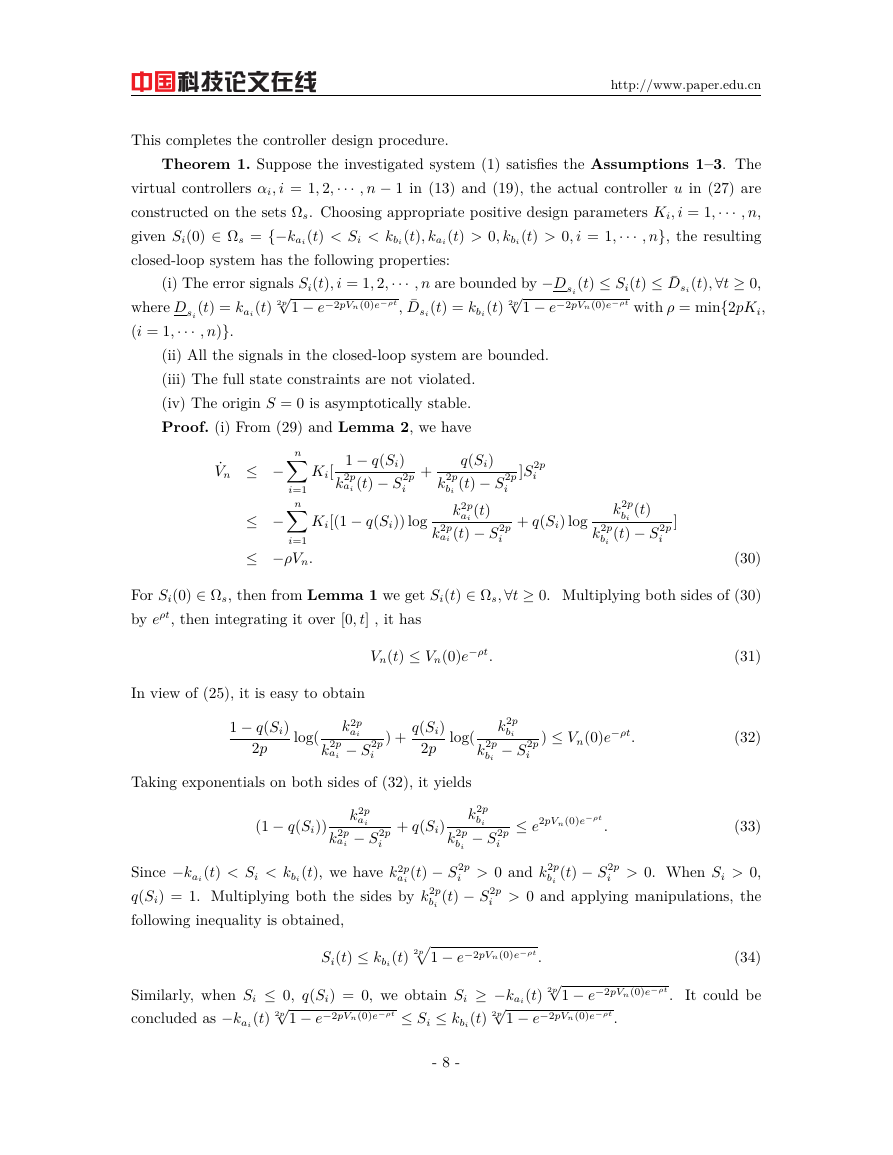








 2023年江西萍乡中考道德与法治真题及答案.doc
2023年江西萍乡中考道德与法治真题及答案.doc 2012年重庆南川中考生物真题及答案.doc
2012年重庆南川中考生物真题及答案.doc 2013年江西师范大学地理学综合及文艺理论基础考研真题.doc
2013年江西师范大学地理学综合及文艺理论基础考研真题.doc 2020年四川甘孜小升初语文真题及答案I卷.doc
2020年四川甘孜小升初语文真题及答案I卷.doc 2020年注册岩土工程师专业基础考试真题及答案.doc
2020年注册岩土工程师专业基础考试真题及答案.doc 2023-2024学年福建省厦门市九年级上学期数学月考试题及答案.doc
2023-2024学年福建省厦门市九年级上学期数学月考试题及答案.doc 2021-2022学年辽宁省沈阳市大东区九年级上学期语文期末试题及答案.doc
2021-2022学年辽宁省沈阳市大东区九年级上学期语文期末试题及答案.doc 2022-2023学年北京东城区初三第一学期物理期末试卷及答案.doc
2022-2023学年北京东城区初三第一学期物理期末试卷及答案.doc 2018上半年江西教师资格初中地理学科知识与教学能力真题及答案.doc
2018上半年江西教师资格初中地理学科知识与教学能力真题及答案.doc 2012年河北国家公务员申论考试真题及答案-省级.doc
2012年河北国家公务员申论考试真题及答案-省级.doc 2020-2021学年江苏省扬州市江都区邵樊片九年级上学期数学第一次质量检测试题及答案.doc
2020-2021学年江苏省扬州市江都区邵樊片九年级上学期数学第一次质量检测试题及答案.doc 2022下半年黑龙江教师资格证中学综合素质真题及答案.doc
2022下半年黑龙江教师资格证中学综合素质真题及答案.doc